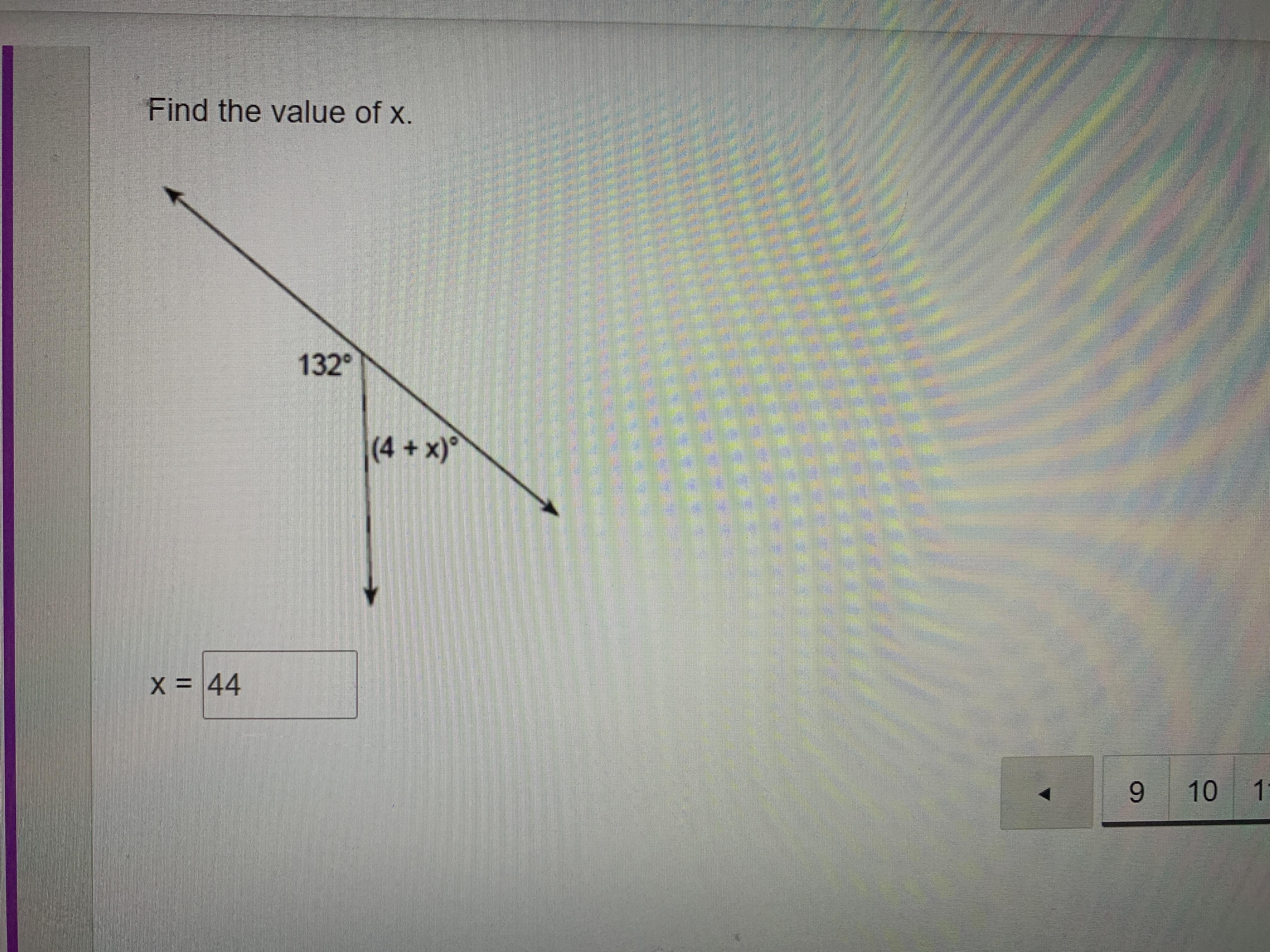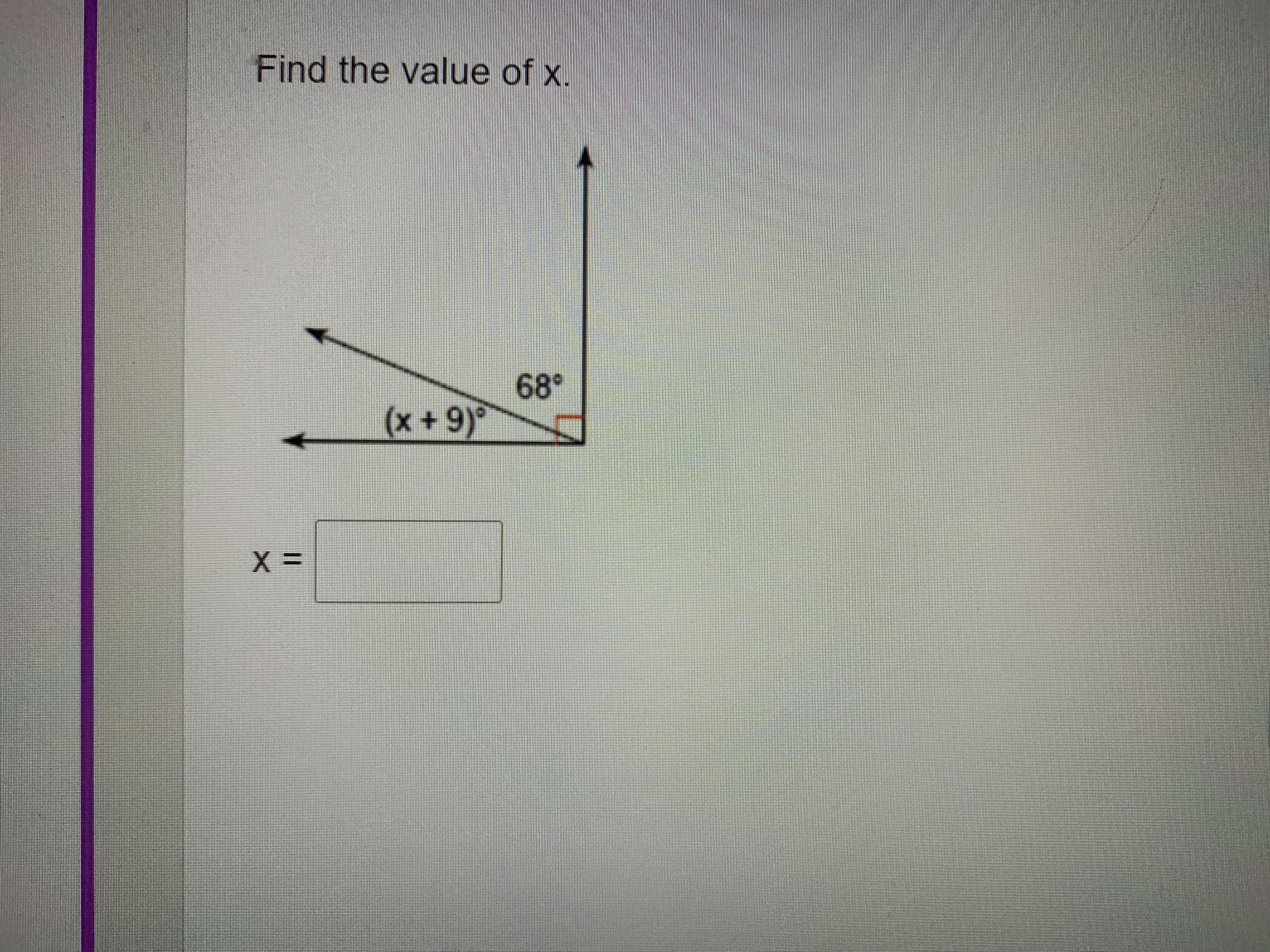Answers
Answer:
sdf
Step-by-step explanation:
sdff
For the first one, 132 and 4 + x make a straight line, and a straight line is 180 degrees, so:
132 + 4 + x = 180
Add 132 and 4.
136 + x = 180
Subtract 136.
x = 44
You are right!
For the second one, 68 + x + 9 form a right angle, and a right angle is 90 degrees, so:
68 + x + 9 = 90
Combine 68 and 9.
77 + x = 90
Subtract 77.
x = 13
Hope this helps
Related Questions
PLEASE HELP!!! IF YOU GIT IT RIGHT I WILL GIVE YOU 90 BRANLY POINTS !!! Which of the following equations is not a proportion? 14/7 = 7/3.5, 1.5/3 = 3/9, 22/33 = 4/6, 2/3 = 142/213
Answers
Answer:
1.5/3=3/9
Step-by-step explanation:
1.5/3=1/2 when 3/9=1/3
I hope this helps :)
Answer:
1.5/3 = 3/9 is not a proportion
Step-by-step explanation:
1.5/3 = 3/9
1.5 divide by 3 is 1/2 but 3 divide by 9 is 1/3 which makes it not proportional
This year, there were 25% fewer sunny days than last year. That’s my question.
Answers
If there were 25% fewer sunny days this year than last year, then there were 25% more sunny days last year than this year and the number of sunny days in the coming year is unknown.
someone please help! I’ll give brainliest!!
Answers
I really need help..
Thanks!
Answers
Brad sells each cup of lemonade for $0.50 he wrote.
Answers
Answer:
What are we supposed to solve??? its incomplete
Step-by-step explanation:
suppose that there were a positive correlation between the variables u and v. if v is 24 when u is 10, which of these is most likely to be the value of v when u is 20?
Answers
Answer: 48
Step-by-step explanation: I got it wrong and it said the correct answer was 48
Divide n by 5 then add 6
Answers
Answer:
n+30/5
Step-by-step explanation:
Simplify n/5
n/5+6
Rewrite the whole as an equivalent fraction
2.1 Add an integer to a fraction
Rewrite the whole as a fraction using 5 as the denominator: 6= 6/1=6×5/5
Equivalent fraction: the fraction thus generated looks different but has the same value as everything.
2.2 sum of the two equivalent fractions add two equivalent fractions that now have a common denominator
Combine the numerators, place the sum or difference over the common denominator, and then reduce to the lowest terms of possible:
n+6×5/5=n+30/5
Before i thought the dividing functions
Answers
a printer can print 12 pages in 9 seconds what is the closest estimate of the number of pages it can print in 1 min
Answers
Answer:
estimated number of pages it can print will 80 in 1 min.
Step-by-step explanation:
If 12 pages/9 Seconds then by multiplying by 60 secs as there are 60 secs in 1 min.
we get
12/9 then multiply by 60 you will get 80 pages in 1 minute.
Number of pages a printer can print in 9 seconds = 12 pages
Number of pages than can be printed in 1 second =
= 12/9
= 1.3 pages
Number of pages that can be printed in 1 second = 0.75 page
Number of pages that can be printed in 1 minute =
= 1 minute = 60 seconds
Number of pages that can be printed in 60 seconds =
= 1.3 × 60
= 78 pages
Rounding off 78 , we get 80 .
Therefore , 80 pages can be printed in 1 minute .
Using these clues, make a quadilateral. Write the name and each side. What is the perimeter?
1. rectangle with sides 7 feet
2. 7feet
3. 10 feet
4. 10feet
Answers
The name of my shape is a parallelogram. The sides are:
7 feet7 feet10 feet10 feetThe perimeter is 34 feet because:
Step 1: Add smaller groups.
10 + 10 = 20
7 + 7 = 14.
Step 2: Add the two numbers.
14 + 20 = 34.
Hope this answer helps you!
Solving each proportions 10/8=n/10
Answers
Answer:
n=12.5
Step-by-step explanation:
10/8=n/10
multiply the denominator and numerators 10 ad 10=100 divide by 8=12.5
Simplify 9 to the 2nd power\ 9 to the 7th power
Answers
Answer:
9^2/9^7 = 9^-5
Step-by-step explanation:
The distance light travels in one year is known as a light year. A light year is equal to 5.87 × 1012 miles. The closest that Earth ever gets to Jupiter is 3.65 × 108 miles. What is a correct representation of the number of years it will take light to travel from Earth to Jupiter at this distance? Check all that apply.
Answers
Answer:
[tex]6.21\times 10^{-5}\ \text{light years}[/tex]
Step-by-step explanation:
The distance light travels in one year is known as a light year.
[tex]1\ \text{light year}=5.87\times 10^{12}\ \text{miles}[/tex]
The closest that Earth ever gets to Jupiter is [tex]3.65\times 10^8\ \text{miles}[/tex]
[tex]3.65\times 10^8\ \text{miles}=\dfrac{1}{5.87\times 10^{12}}\times 3.65\times 10^8\ \text{light years}\\\\=6.21\times 10^{-5}\ \text{light years}[/tex]
Hence, the distance it will take light to travel from Earth to Jupiter at this distance is [tex]6.21\times 10^{-5}\ \text{light years}[/tex]
Which table represents a function?
Answers
Answer:
The table that starts with (-3, -1)
Step-by-step explanation:
For a table to represent a function the x value has to be different number. Such as, the other tables one has two -5, two -2, two -4 and etc. Do you get it
Answer: the first box
-3 -1
0 0
-2 -1
8 1
Step-by-step explanation: the x value can not repet it self but the y value can
how do i graph 2x+4y=12
Answers
Answer:
(0,3) (6,0)
Step-by-step explanation:
Han made some hot chocolate by mixing 4 cups of milk with 6 tablespoons of cocoa
Answers
What is 13 / 143 as a unit fraction
Answers
Answer:1/11
Just got it using some brain cells >:)
Answer:
1/11
Step-by-step explanation:
13/143=1/11
Given m//n, find the value of x
Answers
Answer:
117 is the value of you Question
Step-by-step explanation:
Evaluate the following expression when x = -1, y = 2, z = -3, and
w = 4.
x² - y²
Answers
Answer:
-3
Step-by-step explanation:
-1*-1=1
2*2=4
1-4
=-3
How can you graphically tell if a quadratic equation will have a complex solution?
Answers
Answer:
If it does not cross the x axis.
Step-by-step explanation:
If the quadratic equation does not cross the x axis (or more specifically, if the quadratic is an upward opening parabola and the vertex is above the x axis, or if the quadratic is a downward opening parabola and the vertex is below the x axis), it will have no real solution
The fundamental theorem of algebra says that quadratics must have 2 solutions, so the solutions must be imaginary.
12=6x+3y solve for y
Answers
Answer:
1 1/3 = y
Step-by-step explanation:
12 = 6x + 3y
12 = 9y
12/9 = y
1 1/3 = y
Hope this helped!
Pls Help me. I will mark brainlist.
Answers
Answer:
The second answer
Step-by-step explanation:
Because if you subtract a negative from an equation you get positive (two negatives make a positive)
Flavia needs to build a fence around her dog house, as illustrated on the coordinate grid below. If each unit represents 1 foot, what is the total length of Flavia’s fence in feet?
Answers
Answer:
I would say your answer is (D
Plsss helppppssssss me :< and explain thatttttt
Answers
Answer:
you need to take a better picture nobody can see that i not trying be be rude
Step-by-step explanation:
Answer:
upload clear picture, it is very easy
Step-by-step explanation:
It cost Samantha $4.23 to send 47 text messages. How much does each text cost to send?
Answers
Answer:
456
Step-by-step explanation:
Answer:
i think its 0.09
Step-by-step explanation:
Draw diagonals ACand BDon rectangle ABCD. Measure and record the lengths of the diagonals.
Answers
Answer:
Diagonal Length
AC 7.21
BD 7.21
Step-by-step explanation:
Answer:
Diagonal | Length
AC | 7.21
BD | 7.21
Step-by-step explanation:
-edmentum
write a real world problem that can be solved using the distributive property
Answers
Answer:
10 + 2. 3(10 + 2) = ? something like that I think .
Step-by-step explanation:
need these 3 problems answered
1.(2x-3)^2+24=0
2.(3x+1)^2-49=0
3.3x^2-12x=-45
Answers
Answer:
ummm ................
plz help me with this i do not understand math stuff
Answers
Answer: Pink choice: y= -6x -2
Step-by-step explanation:
In order to be parallel, the slope must be the same. You find the slope as the number or fraction connected to x. ("co-efficient" of x in math talk)
In the given equation, that is -6. (So that knocks out the first two choices)
The other thing to look at is the y-value of the given coordinate,(-1,4)
(The y-value is the second number in the coordinate (x.y) is the pattern)
and compare it to the the last number in the equations in the choices and Here the Yellow choice has y= -6x + 4 so this line can't pass through the coordinate given, because +4 in this equation is where the line crosses the y-axis. ("y-intercept" in math talk) So yellow choice is out!
The attachment shows what the graphs of the choices look like.
The black line is the correct answer. The given coordinate (-1,4) is the labeled red spot. The blue line is the given equation. (You can see where it "intercepts the y-axis on the +3) And the green line also has the -6 slope, but misses the point and intercepts the y-axis at 4.)
I hope the diagram and explanation helps you understand better. It can be confusing.
A carpenter has less than 120 minutes to spend painting furniture each day. Today, he has spent 30.5 minutes painting a desk. Now he will paint x chairs, each of which takes 12.5 minutes. What is the maximum number of chairs the carpenter can paint?
Answers
Answer:
Maximum number of chairs is 7.
Step-by-step explanation:
We are told he has less than 120 minutes to spend painting furniture each day.
Now he has spent 30.5 minutes painting a desk.
Also, he wants to paint "x" number of chairs with each chair taking 12.5 minutes.
Thus, we have;
30.5 + 12.5x < 120
Subtract 30.5 from both sides to get;
12.5x < 120 - 30.5
12.5x < 89.5
x < 89.5/12.5
x < 7.16
Thus, maximum number of chairs he can paint is 7

